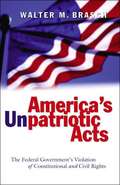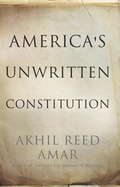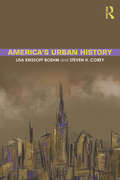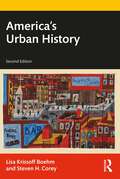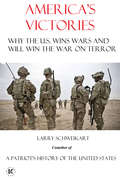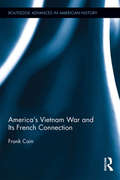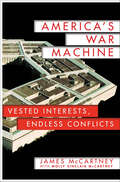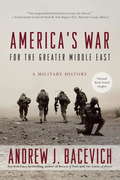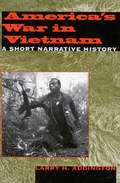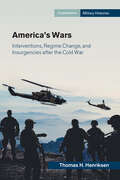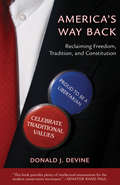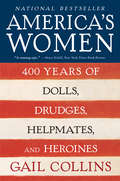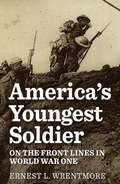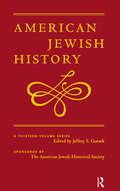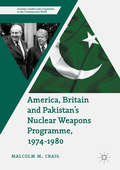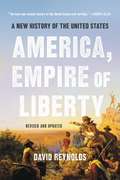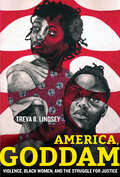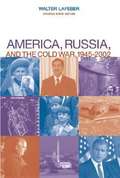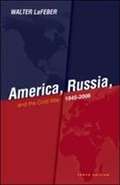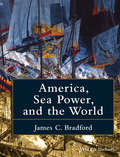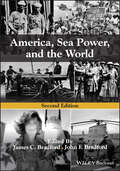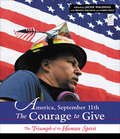- Table View
- List View
America's Unpatriot Acts: The Federal Government's Violation of Constitutional and Civil Rights
by Walter M. BraschWithin six weeks of the 9/11 terrorist attacks, Congress approved the USA Patriot Act, drafted in secret by the Department of Justice. Brasch, an award-winning syndicated columnist and university professor, looks at the effects of the Patriot Act on the nation and at the many civil rights violations conducted in the US, and by the US in foreign countries, during the three years after 9/11. Annotation ©2004 Book News, Inc., Portland, OR (booknews.com)
America's Unwritten Constitution: The Precedents and Principles We Live By
by Akhil Reed AmarDespite its venerated place atop American law and politics, our written Constitution does not enumerate all of the rules and rights, principles and procedures that actually govern modern America. The document makes no explicit mention of cherished concepts like the separation of powers and the rule of law. On some issues, the plain meaning of the text misleads. For example, the text seems to say that the vice president presides over his own impeachment trial-but surely this cannot beright. As esteemed legal scholar Akhil Reed Amar explains inAmerica’s Unwritten Constitution, the solution to many constitutional puzzles lies not solely within the written document, but beyond it-in the vast trove of values, precedents, and practices that complement and complete the terse text. In this sequel toAmerica’s Constitution: A Biography, Amar takes readers on a tour of our nation’sunwrittenConstitution, showing how America’s foundational document cannot be understood in textual isolation. Proper constitutional interpretation depends on a variety of factors, such as the precedents set by early presidents and Congresses; common practices of modern American citizens; venerable judicial decisions; and particularly privileged sources of inspiration and guidance, including theFederalistpapers, William Blackstone’sCommentaries on the Laws of England, the Northwest Ordinance of 1787, Lincoln’s Gettysburg Address, and Martin Luther King, Jr. ’s "I Have a Dream” speech. These diverse supplements are indispensible instruments for making sense of the written Constitution. When used correctly, these extra-textual aids support and enrich the written document without supplanting it. An authoritative work by one of America’s preeminent legal scholars,America’s Unwritten Constitutionpresents a bold new vision of the American constitutional system, showing how the complementary relationship between the Constitution’s written and unwritten components is one of America’s greatest and most enduring strengths.
America's Urban History
by Lisa Krissoff Boehm Steven Hunt CoreyThe history of the American city is, in many ways, the history of the United States. Although rural traditions have also left their impact on the country, cities and urban living have been vital components of America for centuries, and an understanding of the urban experience is essential to comprehending America’s past. America’s Urban History is an engaging and accessible overview of the life of American cities, from Native American settlements before the arrival of Europeans to the present-day landscape of suburban sprawl, urban renewal, and a heavily urbanized population. The book provides readers with a rich chronological and thematic narrative, covering themes including: The role of cities in the European settlement of North America Cities and westward expansion Social reform in the industrialized cities The impact of the New Deal The growth of the suburbs The relationships between urban forms and social issues of race, class, and gender Covering the evolving story of the American city with depth and insight, America's Urban History will be the first stop for all those seeking to explore the American urban experience.
America's Urban History
by Steven H. Corey Lisa Krissoff BoehmIn this second edition, America’s Urban History now includes contemporary analysis of race, immigration, and cities under the Trump administration and has been fully updated with new scholarship on early urbanization, mass incarceration and cities, the Great Society, the diversification of the suburbs, and environmental justice. The United States is one of the most heavily urbanized places in the world, and its urban history is essential to understanding the fundamental narrative of American history. This book is an accessible overview of the history of American cities, including Indigenous settlements, colonial America, the American West, the postwar metropolis, and the present-day landscape of suburban sprawl and an urbanized population. It examines the ways in which urbanization is connected to divisions of society along the lines of race, class, and gender, but it also studies how cities have been sources of opportunity, hope, and success for individuals and the nation. Images, maps, tables, and a guide to further reading provide engaging accompaniment to illustrate key concepts and themes. Spanning centuries of America’s urban past, this book’s depth and insight make it an ideal text for students and scholars in urban studies and American history.
America's Victories: Why America Wins Wars and Why They Will Win the War on Terror
by Larry SchweikartIn America's Victories, Professor Larry Schweikart restores the truth about our amazing military heritage. Just as he did in his acclaimed previous book, A Patriot's History of the United States, Professor Schweikart cuts through the distortions passed along by academia and the media
America's Vietnam War and Its French Connection (Routledge Advances in American History #5)
by Frank CainThat America was drawn into the Vietnam War by the French has been recognized, but rarely explored. This book analyzes the years from 1945 with the French military reconquest of Vietnam until 1963 with the execution of the French-endorsed dictator, Ngo Dinh Diem, demonstrating how the US should not have followed the French into Vietnam. It shows how the Korean War triggered the flow of American military hardware and finances to underpin France’s war against the Marxist-oriented Vietnam Republic led by Ho Chi Minh.
America's War Machine: Vested Interests, Endless Conflicts
by James McCartney Molly Sinclair McCartneyA veteran Washington reporter reveals how years of military-slanted domestic and foreign policy have turned the U.S. into a perpetual war machine.When President Dwight D. Eisenhower prepared to leave the White House in 1961, he did so with an ominous message for the American people about the "disastrous rise" of the military-industrial complex. Fifty years later, the complex has morphed into a virtually unstoppable war machine, one that dictates U.S. economic and foreign policy in a direct and substantial way.Based on his experiences as an award-winning Washington-based reporter covering national security, James McCartney presents a compelling history, from the Cold War to present day that shows that the problem is far worse and far more wide-reaching than anything Eisenhower could have imagined. Big Military has become "too big to fail" and has grown to envelope the nation's political, cultural and intellectual institutions. These centers of power and influence, including the now-complicit White House and Congress, have a vested interest in preparing and waging unnecessary wars. The authors persuasively argue that not one foreign intervention in the past 50 years has made us or the world safer.With additions by Molly Sinclair McCartney, a fellow journalist with 30 years of experience, America's War Machine provides the context for today's national security state and explains what can be done about it.
America's War for the Greater Middle East: A Military History
by Andrew J. BacevichRetired army colonel and New York Times bestselling author Andrew J. Bacevich provides a searing reassessment of U.S. military policy in the Middle East over the past four decades. From the end of World War II until 1980, virtually no American soldiers were killed in action while serving in the Greater Middle East. Since 1990, virtually no American soldiers have been killed in action anywhere else. What caused this shift? Andrew J. Bacevich, one of the country's most respected voices on foreign affairs, offers an incisive critical history of this ongoing military enterprise--now more than thirty years old and with no end in sight. During the 1980s, Bacevich argues, a great transition occurred. As the Cold War wound down, the United States initiated a new conflict--a War for the Greater Middle East--that continues to the present day. The long twilight struggle with the Soviet Union had involved only occasional and sporadic fighting. But as this new war unfolded, hostilities became persistent. From the Balkans and East Africa to the Persian Gulf and Central Asia, U.S. forces embarked upon a seemingly endless series of campaigns across the Islamic world. Few achieved anything remotely like conclusive success. Instead, actions undertaken with expectations of promoting peace and stability produced just the opposite. As a consequence, phrases like "permanent war" and "open-ended war" have become part of everyday discourse. Connecting the dots in a way no other historian has done before, Bacevich weaves a compelling narrative out of episodes as varied as the Beirut bombing of 1983, the Mogadishu firefight of 1993, the invasion of Iraq in 2003, and the rise of ISIS in the present decade. Understanding what America's costly military exertions have wrought requires seeing these seemingly discrete events as parts of a single war. It also requires identifying the errors of judgment made by political leaders in both parties and by senior military officers who share responsibility for what has become a monumental march to folly. This Bacevich unflinchingly does. A twenty-year army veteran who served in Vietnam, Andrew J. Bacevich brings the full weight of his expertise to this vitally important subject. America's War for the Greater Middle East is a bracing after-action report from the front lines of history. It will fundamentally change the way we view America's engagement in the world's most volatile region. Praise for America's War for the Greater Middle East"Bacevich is thought-provoking, profane and fearless. . . . [His] call for Americans to rethink their nation's militarized approach to the Middle East is incisive, urgent and essential."--The New York Times Book Review "Bacevich's magnum opus . . . a deft and rhythmic polemic aimed at America's failures in the Middle East from the end of Jimmy Carter's presidency to the present."--Robert D. Kaplan, The Wall Street Journal "[A] monumental new work . . . One of the grim and eerie wonders of his book is the way in which just about every wrongheaded thing Washington did in that region in the fourteen-plus years since 9/11 had its surprising precursor in the two decades of American war there before the World Trade Center towers came down."--The Huffington Post "An unparalleled historical tour de force certain to affect the formation of future U.S. foreign policy."--Lieutenant General Paul K. Van Riper, U.S. Marine Corps (Ret.)From the Hardcover edition.
America's War in Vietnam: A Short Narrative History
by Larry H. Addington&“If you want to read one book about Vietnam, read this one.&” —New York Review of Books Drawing on years of experience teaching about the war, Larry H. Addington presents a short, narrative history of the origins, course, and outcome of America&’s military involvement in Vietnam. Not intended as a competitor to the many excellent comprehensive studies of the Vietnam Era, this book will prove a useful introduction and a concise reference to America&’s longest, most controversial war. Addington reviews the history of pre-colonial Vietnam, the impact of French imperialism and the Indochina War, and the Cold War origins of American involvement. He then details US policy after the 1954 Geneva Accords, its role in the establishment of South Vietnam, and the outbreak of a new war. Turning to America&’s deepening involvement, Addington examines the US strategies for waging air and ground war, the impact of the war at home, and the reasons for the failure of US policy under President Johnson. He studies the successes and failures of the policy of withdrawal under President Nixon and concludes with an overview of the war&’s aftermath and its legacy.
America's Wars: Interventions, Regime Change, and Insurgencies after the Cold War (Cambridge Military Histories)
by Thomas H. HenriksenThe collapse of the Soviet Union ushered in American global hegemony in world affairs. In the post-Cold War period, both Democrat and Republican governments intervened, fought insurgencies, and changed regimes. In America's Wars, Thomas Henriksen explores how America tried to remake the world by militarily invading a host of nations beset with civil wars, ethnic cleansing, brutal dictators, and devastating humanitarian conditions. The immediate post-Cold War years saw the United States carrying out interventions in the name of Western-style democracy, humanitarianism, and liberal internationalism in Panama, Somalia, Haiti, Bosnia and Kosovo. Later, the 9/11 terrorist attacks led America into larger-scale military incursions to defend itself from further assaults by al Qaeda in Afghanistan and from perceived nuclear arms in Iraq, while fighting small-footprint conflicts in Africa, Asia, and Arabia. This era is coming to an end with the resurgence of great power rivalry and rising threats from China and Russia.
America's Way Back: Reclaiming Freedom, Tradition, and Constitution
by Donald Devine&“The solution for the modern GOP . . . Intellectual ammunition for the modern conservative movement.&” —SENATOR RAND PAULHow can America recover from economic stagnation, moral exhaustion, and looming bankruptcy? Donald J. Devine shows the way.Devine, a longtime adviser to Ronald Reagan, lays out a powerful case for the philosophical synthesis of freedom and tradition that Reagan said was the essence of modern conservatism. The secret of America&’s success, he shows, has been the Constitution&’s capacity to harmonize the twin ideals of freedom and tradition. But today, progressivism has so corrupted modern political thinking—in both parties—that leaders keep calling for the same failed tactics: more money poured into more big-government programs.In America&’s Way Back, Devine not only reveals where things went wrong, and why, but also points the way to reclaiming America&’s freedom, prosperity, and creativity. The solution lies in a new &“fusion&” of traditional and libertarian thought.
America's Women
by Gail CollinsAmerica's Women tells the story of more than four centuries of history. It features a stunning array of personalities, from the women peering worriedly over the side of the Mayflower to feminists having a grand old time protesting beauty pageants and bridal fairs. Courageous, silly, funny, and heartbreaking, these women shaped the nation and our vision of what it means to be female in America. <P><P>By culling the most fascinating characters -- the average as well as the celebrated -- Gail Collins, the editorial page editor at the New York Times, charts a journey that shows how women lived, what they cared about, and how they felt about marriage, sex, and work. She begins with the lost colony of Roanoke and the early southern "tobacco brides" who came looking for a husband and sometimes -- thanks to the stupendously high mortality rate -- wound up marrying their way through three or four. Spanning wars, the pioneering days, the fight for suffrage, the Depression, the era of Rosie the Riveter, the civil rights movement, and the feminist rebellion of the 1970s, America's Women describes the way women's lives were altered by dress fashions, medical advances, rules of hygiene, social theories about sex and courtship, and the ever-changing attitudes toward education, work, and politics. While keeping her eye on the big picture, Collins still notes that corsets and uncomfortable shoes mattered a lot, too. <P><P>"The history of American women is about the fight for freedom," Collins writes in her introduction, "but it's less a war against oppressive men than a struggle to straighten out the perpetually mixed message about women's roles that was accepted by almost everybody of both genders." <P><P>Told chronologically through the compelling stories of individual lives that, linked together, provide a complete picture of the American woman's experience, America's Women is both a great read and a landmark work of history.
America's Youngest Soldier
by Ernest L. WrentmoreAmerica's Youngest Soldier, originally published in 1958 as In Spite of Hell, is the gripping account of Ernest L. Wrentmore, the youngest soldier in the American Expeditionary Force during World War One. Wrentmore served with honor despite his age (two months shy of his thirteenth birthday at the time of his enlistment in September 1917), and despite the horrors he witnessed in the trenches in France. Wrentmore saw front-line service on three battle fronts, and was cited for bravery for delivering a message, under fire, that made it possible for his unit to advance. Wrentmore was wounded twice and severely gassed; and on the night of October 17, 1918, he was evacuated from the field of battle during the first phase of the Meuse-Argonne offensive.
America, American Jews, and the Holocaust: American Jewish History (American Jewish History #4)
by Jeffrey S. GurockThis volume incorporates studies of the persecution of the Jews in Germany, the respective responses of the German-American Press and the American-Jewish Press during the emergence of Nazism, and the subsequent issues of rescue during the holocaust and policies towards the displaced.
America, América: A New History of the New World
by Greg GrandinA 2025 Kirkus Prize finalist in Nonfiction • Shortlisted for the 2025 Cundill History Prize <BR> “An extraordinarily ambitious book . . . America, América reads at times as the historical equivalent of the great epic novels of Gabriel García Márquez.” —Irish Times <P><P> From the Pulitzer Prize–winning historian, the first comprehensive history of the Western Hemisphere, a sweeping five-century narrative of North and South America that redefines our understanding of both. <P><P> The story of how the United States&’ identity was formed is almost invariably told by looking east to Europe. But as Greg Grandin vividly demonstrates, the nation’s unique sense of itself was in fact forged facing south toward Latin America. In turn, Latin America developed its own identity in struggle with the looming colossus to the north. In this stunningly original reinterpretation of the New World, Grandin reveals how North and South emerged from a constant, turbulent engagement with each other. <P><P> America, América traverses half a millennium, from the Spanish Conquest—the greatest mortality event in human history—through the eighteenth-century wars for independence, the Monroe Doctrine, the coups and revolutions of the twentieth century, and beyond. Grandin shows, among other things, how in response to U.S. interventions, Latin Americans remade the rules, leading directly to the founding of the United Nations; and how the Good Neighbor Policy allowed FDR to assume the moral authority to lead the fight against world fascism. <P><P> Grandin’s book sheds new light on well-known historical figures like Bartolomé de las Casas, Simón Bolívar, and Woodrow Wilson, as well as lesser-known actors such as the Venezuelan Francisco de Miranda, who almost lost his head in the French Revolution and conspired with Alexander Hamilton to free America from Spain; the Colombian Jorge Gaitán, whose unsolved murder inaugurated the rise of Cold War political terror, death squads, and disappearances; and the radical journalist Ernest Gruening, who, in championing non-interventionism in Latin America, helped broker the most spectacularly successful policy reversal in United States history. <P><P> This is a monumental work of scholarship that will fundamentally change the way we think of Spanish and English colonialism, slavery and racism, and the rise of universal humanism. At once comprehensive and accessible, America, América shows that centuries of bloodshed and diplomacy not only helped shape the political identities of the United States and Latin America but also the laws, institutions, and ideals that govern the modern world. In so doing, Grandin argues that Latin America’s deeply held culture of social democracy can be an effective counterweight to today’s spreading rightwing authoritarianism. A culmination of a decades-long engagement with hemispheric history, drawing on a vast array of sources, and told with authority and flair, this is a genuinely new history of the New World. <P><P> <b>New York Times Bestseller</b>•
America, Britain and Pakistan’s Nuclear Weapons Programme, 1974-1980: A Dream of Nightmare Proportions (Security, Conflict and Cooperation in the Contemporary World)
by Malcolm M. CraigThis book analyses US and UK efforts to shut down Pakistan's nuclear programme in the 1970s, between the catalytic Indian nuclear test of May 1974 and the decline of sustained non-proliferation activity from mid-1979 onwards. It is a tale of cooperation between Washington and London, but also a story of divisions and disputes. The brutal economic realities of the decade, globalisation, and wider geopolitical challenges all complicated this relationship. Policy and action were also affected by changes elsewhere in the world. Iran's 1979 revolution brought a new form of political Islamic radicalism to prominence. The fears engendered by the Ayatollah and his followers, coupled to the blustering rhetoric of Pakistani leaders, gave rise to the 'Islamic bomb', a nuclear weapon supposedly created by Pakistan to be shared amongst the Muslim ummah. This study thus combines cultural, diplomatic, economic, and political history to offer a rigorous, deeply researched account of a critical moment in nuclear history.
America, Empire of Liberty: A New History of the United States
by David ReynoldsIt was Thomas Jefferson who envisioned the United States as a great "empire of liberty. ” This paradoxical phrase may be the key to the American saga: How could the anti-empire of 1776 became the world’s greatest superpower? And how did the country that offered unmatched liberty nevertheless found its prosperity on slavery and the dispossession of Native Americans? In this new single-volume history spanning the entire course of US history-from 1776 through the election of Barack Obama-prize-winning historian David Reynolds explains how tensions between empire and liberty have often been resolved by faith-both the evangelical Protestantism that has energized American politics for centuries and the larger faith in American righteousness that has driven the country’s expansion. Written with verve and insight,Empire of Libertybrilliantly depicts America in all of its many contradictions.
America, Goddam: Violence, Black Women, and the Struggle for Justice
by Treva B. LindseyOne of the Best Nonfiction Books of 2022, Kirkus Reviews "A righteous indictment of racism and misogyny."—Publishers WeeklyA powerful account of violence against Black women and girls in the United States and their fight for liberation. Echoing the energy of Nina Simone's searing protest song that inspired the title, this book is a call to action in our collective journey toward just futures.America, Goddam explores the combined force of anti-Blackness, misogyny, patriarchy, and capitalism in the lives of Black women and girls in the United States today. Through personal accounts and hard-hitting analysis, Black feminist historian Treva B. Lindsey starkly assesses the forms and legacies of violence against Black women and girls, as well as their demands for justice for themselves and their communities. Combining history, theory, and memoir, America, Goddam renders visible the gender dynamics of anti-Black violence. Black women and girls occupy a unique status of vulnerability to harm and death, while the circumstances and traumas of this violence go underreported and understudied. America, Goddam allows readers to understand How Black women—who have been both victims of anti-Black violence as well as frontline participants—are rarely the focus of Black freedom movements. How Black women have led movements demanding justice for Breonna Taylor, Sandra Bland, Toyin Salau, Riah Milton, Aiyana Stanley-Jones, and countless other Black women and girls whose lives have been curtailed by numerous forms of violence. How across generations and centuries, their refusal to remain silent about violence against them led to Black liberation through organizing and radical politics. America, Goddam powerfully demonstrates that the struggle for justice begins with reckoning with the pervasiveness of violence against Black women and girls in the United States.
America, Past and Present, Volume 2 10th Edition
by H. W. Brands T. H. Breen Robert A. Divine R. Hal Williams Ariela J. GrossAmerica, Past and Present, Volume 2 focuses students on the story of American history. The book integrates the social and political dimensions of American history into one chronological narrative, providing students with a full picture of the scope and complexity of the American past. It tells the story of all Americans elite and ordinary, women and men, rich and poor, white majority and minorities.
America, Russia, and the Cold War 1945-2002 (Updated Ninth Edition)
by Walter LafeberProfessor LaFeber explains the course of the Cold War as it moved from periods of intense crisis and confrontation to times of relative stability.
America, Russia, and the Cold War, 1945-2006 (Tenth Edition)
by Walter LafeberUsing extensive materials from both published and private sources, this concise text focuses on United States-Soviet diplomacy to explain the causes and consequences of the Cold War. It explores how the Cold War was shaped by domestic events in both the U. S. and the Soviet Union and presents a variety of other points of view on the conflict--Chinese, Latin American, European, and Vietnamese. The text includes both engaging anecdotes and quotes from primary sources to support key points and exemplify policies, and recent scholarship and materials from openings of the U. S. , Soviet, and Chinese archives.
America, Sea Power, and the World
by James C. BradfordThis survey of American naval history features original chapters from key scholars in the field that trace the relationship between the American Navy and the position of the United States on the global political stage over the past 250 years. Places equal weight on the influence of major wartime campaigns and naval efforts to defend and expand America’s political and economic interests during times of peace Includes an array of illustrations and 56 new maps, seamlessly integrated within each chapter Each chapter features sidebars with biographical sketches of influential leaders and descriptions of weapons and technological developments of the era
America, Sea Power, and the World
by James C. Bradford John F. BradfordThe gold standard in college-level American naval history texts, edited by the foremost scholar in the field In the newly revised second edition of America, Sea Power and the World, a team of distinguished researchers delivers an extensive and authoritative survey of American naval history, the place of the United States in world affairs, and the role of that country’s naval forces during peacetime and wartime. Each chapter contains a comprehensive analysis of its subject as well as brief sidebars describing a key weapon or technological development of the era and a short biographical sketch of an influential leader or representative of the navy from that era. The book offers extensive illustration and maps and a throughgoing emphasis on naval policy, strategy, roles, and missions, with careful attention paid to naval operations. These factors given greater focus than the descriptions of battle tactics found in other texts. Readers will also find: A thorough introduction to sea power and the modern state system, as well as the American War for Independence at sea Comprehensive explorations of the genesis of the United States Navy from 1785 to 1806 Practical discussions of the Naval War of 1812 and the Confirmation of Independence from 1807 to 1815 and the Squadron Navy as an agent of the commercial empire until 1890 Fulsome treatments of the Second World War in the Atlantic, Mediterranean, and the Pacific, including defensive actions in the Pacific from 1937 to 1943 and offensive actions from 1943 to 1944. New chapters exclusive to the 2nd edition focused on the history of African Americans and women in the US Navy, the development of joint operations and unified command, and the naval history of the last two decades.Perfect for undergraduate students taking courses on the naval history of the United States, America, Sea Power and the World, Second Edition will also earn a place in the libraries of members of the general public interested in naval and military history.
America, September 11th: The Triumph of the Human Spirit (Call to Action Books)
by Karen Frost Brenda WelchlinTrue stories of compassion, heroism, and kindness in the midst of a historic tragedy.Every tragedy has its heroes, and there were many in the terrorist attacks on New York City and Washington, D.C., on 9/11 and in the difficult days that followed. In this inspiring volume, Jackie Waldman, author of The Courage to Give, has collected the dramatic stories of some of the firefighters, rescue workers, police, medics, relatives searching for missing loved ones, and everyday people who, in the face of horror, sprang into action to save lives and help their communities. From the ASPCA leader who lost a sister that day and went on to lead an effort to rescue abandoned pets from the area, to the music student who went to Ground Zero to play for the toiling rescue workers, these vivid accounts, written in the immediate aftermath, paint a vivid picture of that infamous event—and remind us of what is best in us even in the worst of times.
